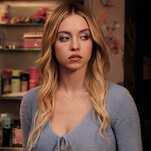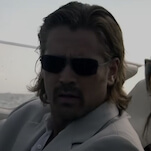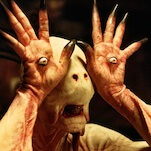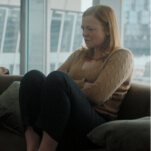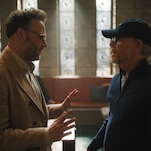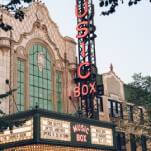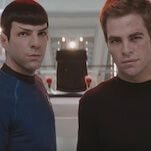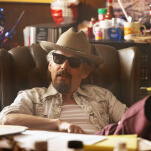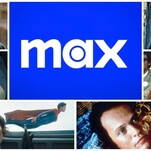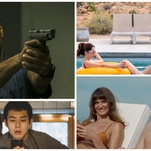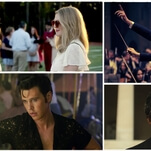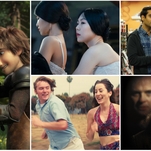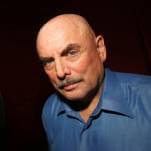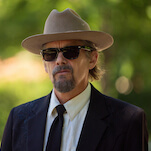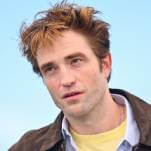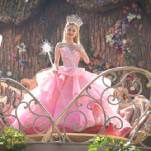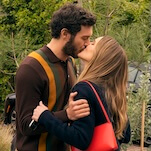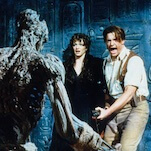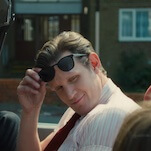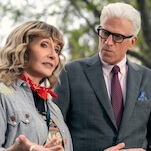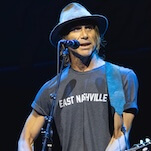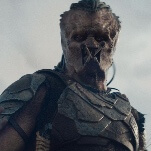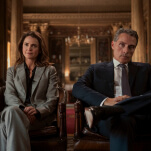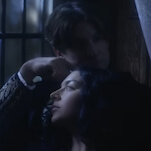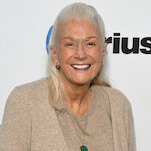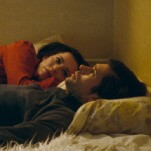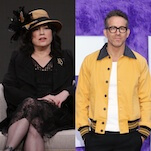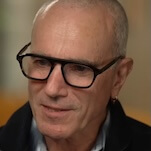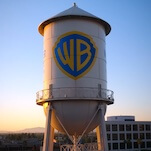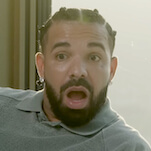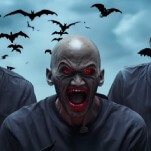7. Rick Rubin’s (possibly haunted) Laurel Canyon mansion (Red Hot Chili Peppers, Blood Sugar Sex Magik)
Anthony Kiedis wanted to avoid “the anal retentive vibrations of the sterilicity” involved with recording in a traditional studio, which is why Red Hot Chili Peppers ended up making its 1991 breakthrough, Blood Sugar Sex Magik, in Rick Rubin’s Laurel Canyon mansion. James Murphy of LCD Soundsystem, who recorded 2010’s This Is Happening there, more succinctly described his motivation to record in the grand house: “Because it would be awesome, dude. Have you seen this place?” Indeed it is awesome, but is it awesomely haunted as well? In the documentary Funky Monks, which details the making of BSSM, Flea explains that drummer Chad Smith was afraid to live in the house—often called the Harry Houdini mansion, though it may not be on the same property where the magician’s one-time house burned down—which was said to be haunted by a door-opening apparition. Spooky ghosts, along with odd stories from guitarist John Frusciante—about life in the fourth dimension and seeing his erections as the enemy—probably made commuting the best option for Smith.
8. Switzerland’s Grand Hotel (Deep Purple, Machine Head)
Released in 1972 and bearing the primitive proto-metal anthem “Smoke On The Water,” Deep Purple’s Machine Head had an appropriately head-banging birth—even if most of that head-banging was due to sheer frustration. The band’s initial plan to record in Switzerland’s popular Montreux Casino was thwarted after a fire at a Frank Zappa concert ruined the venue’s roof. Deep Purple, whose singer, Ian Gillan, was suffering from hepatitis and recording against his doctor’s orders, relocated The Rolling Stones’ mobile studio to a nearby theater called the Pavilion, but noise complaints drove the band to the Grand Hotel. There, the crew ran a labyrinthine tangle of cables throughout the hotel and into recording equipment installed in a van parked outside. (Mattresses stacked against the walls provided insulation.) The whole place became such a mess, the band stopped climbing through it to get the van and listen to playbacks. In spite of all those negative vibes, Machine Head became Deep Purple’s biggest album, and a milestone in the development of heavy metal.
9. Slane Castle (U2, The Unforgettable Fire)
In 1981, U2 appeared on the bill at the first Slane Concert, held in an open field down a hill from Slane Castle in Ireland’s County Meath. In 1984, the band moved indoors to record its fourth album, The Unforgettable Fire, the follow-up to the worldwide hit War. Working with producer Brian Eno, U2 set out to step back from its usual crowd-stirring anthems to explore a more atmospheric, “European” sound. After a month of living and playing at Slane—where the band enjoyed being able to improvise together in one big room—U2 moved to Dublin’s Windmill Lane Studios to turn its experiments into finished songs. The work at Windmill produced some recognizably U2-y music (including the single “Pride (In The Name Of Love),” which the band couldn’t perfect at Slane), but in the documentary about the making of The Unforgettable Fire, the band members are clearly more stressed and touchy in a real studio. According to The Edge in liner notes to the album’s 25th-anniversary edition, “Slane Castle had so much more ambient personality.”
10. Church Of The Holy Trinity (Cowboy Junkies, The Trinity Session)
The Toronto country-rockers in Cowboy Junkies were barely known outside of Canada when they assembled in the historic Church Of The Holy Trinity to make their second album. Following the model of its debut, Whites Off Earth Now!!, the band recorded live, gathered around a single microphone—which suited the circumstances, as it was supposed to be in and out of the church in one day. Brothers Michael and Peter Timmins, their sister Margo, and Alan Anton hired local musicians and rehearsed with them primarily over the phone, then spent most of the first few hours at Trinity figuring out where to position everybody and how to place their one mic. Once they found the sweet spot, according to Michael Timmins (in a memoir on the band’s website), “No song took more than three or four takes to capture and every musician seemed to be connecting with each other on a very subconscious plain. We were all having one of those magical moments that musicians rarely find themselves in, when the music takes over and you feel like you aren’t really responsible for what you are doing… you are just the channeler.” The Trinity Session was released in Canada in 1988, then picked up by RCA and released more widely. It became a surprise hit, partly because of the pleasantly reverberating sound, and partly because of the story of how that sound was achieved. In fact, The Trinity Session became such a landmark that 20 years later, Cowboy Junkies returned to Trinity to record a tribute to their own breakthrough album.
11. Various spots on Jackson Browne’s tour (Jackson Browne, Running On Empty)
Jackson Browne wasn’t the first rocker to record an album of new material on tour. Neil Young, for one, beat him to it with 1973’s Time Fades Away. But Browne made his method integral to the theme of Running On Empty by recording a set of originals and covers largely about life on the road. Browne and his touring band recorded songs in concert, backstage, on the bus, and in hotel rooms, and sang about loneliness, exhaustion, drugs, boredom, and backbreaking labor. Like Young, Browne aimed for a kind of audio vérité, intended to capture the immediacy of the creative process and the ways real life seeps in and influences it. Because Browne came through with some of his catchiest material—like the title track, “You Love The Thunder,” and the medley of “The Load-Out” and the doo-wop classic “Stay”—Running On Empty became his biggest hit. In the years since, other artists have followed the Young/Browne model, including Joe Jackson, who recorded his Big World in concert (but edited out any crowd noise), and R.E.M., which recorded much of New Adventures In Hi-Fi during sound-checks on the Monster tour.
12. Various Faith No More hotel rooms (Mike Patton, Adult Themes For Voice)
The hotel room isn’t the rarest of recording settings, but Mike Patton put his own inimitably warped twist on the tradition during Faith No More’s 1995 world tour. While the rest of the band went out cavorting through a cornucopia of bona fide exotic locales—Sao Paolo, Tel Aviv, Vienna, Wollongong, and um, Jacksonville—Patton hunkered down with a TASCAM 4-Track Portastudio, a Gideon’s Bible, and an endlessly identical splay of hideous furnishings, creating his own unusual atmosphere using only one instrument: his voice. Completely bereft of melody, Adult Themes is a collection of whispers, howls, lip-smacks, screeches, moans, glottal stops, and guttural grunts meticulously arranged to compose a gag-inducing splay of symphonic sound. Sample track title: “Porno Holocaust.” Patton diehards can revisit the scenes of this inspired aural crime thanks to the liner notes’ detailed list of the recording locations, including room numbers.
[pagebreak]
13. Various historic sites (John Mellencamp, No Better Than This)
John Mellencamp kept the peripatetic recording tradition alive with his 2010 album No Better Than This. Working with T-Bone Burnett and a fine, roots-attuned band, Mellencamp set up shop at historic locations like Sun Studios, Savannah’s First African Baptist Church, and the San Antonio Hotel where Robert Johnson cut some of his most famous sides. Presumptuous? Maybe. But while No Better Than This doesn’t live up to the legends of the surroundings in which it was recorded, it’s far from embarrassing.
14. All over the U.S. on an iPad (Gorillaz, The Fall)
Recording while touring is a fairly common practice, but there was nothing common about Gorillaz’s 2010 tour. Mastermind Damon Albarn wrangled a three-ring circus of monstrous talent to perform his virtual band’s third album, Plastic Beach. Eight busses were needed to transport the crew and players, which included De La Soul, half of The Clash, Bobby Womack, Miho Hatori, and the American Syrian Orchestra. After spending two decades trying to crack the North American continent via Blur and his other projects, Albarn finally blew it wide open and decided to celebrate by recording a contrastingly simple record. The Fall was made entirely on an iPad over 32 days spent on the highways of the U.S. and Canada, and it pays tribute to those surroundings with song titles like “Phoner To Arizona” and “The Snake In Dallas.” Paul Simonon, Mick Jones, and Bobby Womack make appearances too, as does an odd piece of Americana known as the Archie McPhee Yodelling Pickle.
15. A Norwegian prison (Burzum, Dauði Baldrs and Hliðskjálf)
Plenty of rappers have literally phoned in their performances from prison. But few musical outlaws can touch Norwegian black-metal legend Varg Vikernes. While serving 15 years of a 21-year sentence for stabbing his Mayhem bandmate Øystein Aarseth to death (oh, and burning down some churches), Vikernes continued his solo project, Burzum, from his jail cell. The catch: He wasn’t allowed guitars, amps, or drums. Armed with only a synthesizer, he made two albums—1997’s Dauði Baldrs and 1999’s Hliðskjálf—full of haunting, symphonic, thoroughly bone-chilling ambient music. Since being released on parole in 2009, he’s recorded two new albums and remained busy spouting his neo-Nazi beliefs, so you never know: There’s always a chance for another prison-made Burzum album sometime in the future.
16. Abandoned grain silo (Great Lake Swimmers, Great Lake Swimmers)
Great Lake Swimmers have an impressive track record of recording in unusual spots. The site of 2009’s Lost Channels, Singer Castle on Dark Island in the St. Lawrence Seaway, is an auspicious leap forward from the abandoned grain silo in Southern Ontario used to record the band’s self-titled 2003 debut. In a 2009 video for the web series Camera Music, Tony Dekker recreates what a typical day of recording must have been like: driving from the city to a silo in the country, being really careful not to step on a nail as he trudges through the overgrown brush, awkwardly climbing through a tiny opening, and hoping someone doesn’t come kick him out as he performs the lead track from the album, “Moving Pictures, Silent Films.”
17. A houseboat (Pink Floyd, A Momentary Lapse Of Reason and The Division Bell)
Originally built in 1911 for a busker and impresario named Fred Karno, the lavish houseboat Astoria, now owned by Pink Floyd guitarist David Gilmour, boasts all kinds of amenities, including a marble bathroom and a deck capable of housing a 90-piece orchestra. But when Floyd recorded 1987’s A Momentary Lapse Of Reason and 1994’s The Division Bell on the Astoria, the band preferred less grandiose environs, working in one of the smaller cabins down below. Space was so tight, Gilmour couldn’t even fit his guitar amps in the room. The main draw of Astoria for Gilmour was the natural beauty. “I’ve spent half my life in airless recording studios [with] no windows [and] no light,” Gilmour says in the BBC documentary Three Men In A Boat. “And then you get here and it’s beautiful.”
18. London’s Queen Charlotte’s Hospital (John Lennon and Yoko Ono, Unfinished Music No. 2: Life With The Lions)
Attempting to build their lives and marriage into art, John Lennon and Yoko Ono released Unfinished Music No. 2: Life With The Lions, an avant-garde conceptual album that deals largely with one of Ono’s miscarriages. On side two, the couple takes a tape recorder into Queen Charlotte’s Hospital in London, where they document their hospital stay in four tracks. They head into the hospital expecting to be released in a few days. Then the first track seems to make light of the situation before things turn bad: In “No Bed For Beatle John,” five-months-pregnant Ono gives a simple melody to a newspaper article explaining that John had to give up his bed because the hospital needed the space—the cover photograph shows him seated on some pillows by her bed—and projects a good outcome for the baby’s survival. (Ono also sings another article referencing Unfinished Music No. 1, which was refused by both EMI and Capitol Records, due to the nude cover art.) The next two tracks record the baby’s life and death: the baby’s heartbeat, then two minutes of silence for their lost child.
19. A speeding car, a hot-air balloon, and an old mining cave, among lots of other places (Herbert, Scale)
Artists trying to think outside the box, don’t even think of trying to mess with Matthew Herbert. His poppy, organic house music comes out of the tradition of musique concrete, meaning he makes music from elements not traditionally considered musical. It works well with his overtly political stances on records like 2006’s Plat Du Jour, where he expounded on the state of food production by recording chicks being born and toast being made. For Bodily Functions, he made tracks by manipulating human hair and organs. It sounds a little convoluted, sure, but the whole process really came to fruition on 2006’s excellent Scale, where Herbert somehow managed to make complex, catchy, lush tracks by sampling everything from a coffin to a gas pump. Herbert worked under the theory that different atmospheres could change a musician’s mentality, and thus the music, so all the drums on the record were recorded in various states of drummer distress—in the back seat of Herbert’s car as he drove 100 mph, in a hot-air balloon at 2,000 feet, in an old mining cave, and in the sea by Herbert’s house in England.
20. Outdoors near Lake Wandawega, Wisconsin (Chris Connelly, The Episodes)
Chris Connelly has spent roughly 20 years as a solo artist aggressively experimenting with musical norms, a habit he acquired during his early days as a member of the Scottish proto-industrial outfit Finitribe (and later in Ministry and Revolting Cocks). In producer Tim Kinsella (Joan Of Arc, Make Believe, Cap’n Jazz), he found a kindred spirit in strangeness, so it was not at all odd that Kinsella suggested recording parts of Connelly’s eighth solo album, The Episodes, outside near Lake Wandawega, Wisconsin, or that Connelly considered it a great idea. “It was freezing cold,” Connelly told The A.V. Club in 2007. “You can actually hear in the middle of “[The Son Of] Empty Sam” the rain starts, and at the end you can hear pulling garbage bags over the microphones—microphones that cost thousands and thousands of dollars. It took us so long to get a good take of that song, because we would be in like minute eight of recording it, and I’d be like, ‘Stop. Raining.’”
21. Eric Bachmann’s van (Eric Bachmann, To The Races)
Eric Bachmann—former (and future?) Archers Of Loaf and current Crooked Fingers frontman—recorded his spare, gorgeous 2006 solo debut To The Races in the back of a van that was also serving as his home at the time. Though associated with the Chapel Hill indie-rock scene of the mid-’90s, Bachmann has lived all over since forming Crooked Fingers in 2000, from China to Denver to Seattle to Georgia. The songs on To The Races were mostly recorded outside Seattle in the cramped interior, which included a little sleeping loft in addition to recording gear. The claustrophobia is evident on the songs, which are beautifully sad—and some of the best he’s ever written.
22. The backseat of a 1965 AMC Rambler American (Ben Vaughn, Rambler ’65)
A lover of both roots music and cars, Ben Vaughn overlapped the two on his 1997 album Rambler ‘65, recorded in the back seat of his 1965 AMC Rambler American. The album’s recording location was inspired by a joke during a demo recording session, but Vaughn warmed to the idea, hoping to capture the sound of AM radio hits of his youth. An initial demo gave Vaughn just the sound he was looking for, as he said in a later interview: “It sounded like one of those early Dylan albums, like folk albums used to sound before they started recording guitars beautifully… It has an edge to it, an immediacy that you just don’t get in the studio.” That edge and immediacy are present in peppy gold nuggets like “7 Days Without Love” and “Boomerang,” hook-laden songs that hearken back to the early days of AM rock ’n’ roll radio. The album’s slower cuts, like “Song For You” and “Too Much Sorrow,” also benefit from the stripped-down presentation, gaining an extra layer of intimacy. The recording locale has contributed greatly to the album’s legend, but that legend lives on primarily because the record is damn good.
23. Johnny Quaid’s grandparents’ farm (My Morning Jacket, It Still Moves)
It was a shame when Johnny Quaid left My Morning Jacket. Sure, the guy is a solid axe-slinger, but his greatest gift to the Kentucky band was his grandparents’ farm in Shelbyville. The group recorded its first three records there, both in the proper studio that Quaid set up (dubbed Above The Cadillac) and in the property’s various nooks, crannies, and outbuildings. The Tennessee Fire (1999) and At Dawn (2001) hold up as shining examples of a fantastic group learning to coax its fresh, haunted take on Americana from wherever it’d been hiding, but on 2003’s It Still Moves, MMJ hit its stride. What pushed the album over into masterpiece territory was the decision to record Jim James’ soaring vocals in an empty grain silo. With money from a freshly inked deal with Dave Matthews’ ATO Records, Quaid and the band wired the place to perfection, and wound up capturing one of the greatest reverbs ever put to tape.
24. A house in the woods and a bucket of manure (Neil Young & Crazy Horse, Ragged Glory)
A lot of classic-rock icons had pretty a desultory ’80s (cf. Bob Dylan, The Rolling Stones), but Neil Young’s was perverse, as he explored rockabilly, techno, bog-standard AOR, country—just about anything but the classic scrawling guitar and hard whomp he made in his ’70s heyday with his ultimate band, Crazy Horse. So 1990’s Ragged Glory got old heads excited again: Raw, rangy, and wonderfully vibrant, it was Young’s live-est recording in a decade. It was recorded in a secluded home studio near Young’s Northern California ranch, yet the most distinctive set-and-setting came about on a song that wound up as a B-side of Glory’s single, “Mansion On The Hill.” To record “Don’t Spook the Horse,” Young stood barefoot in a bucket of cow shit while cutting his vocal. The track is big and woozy—no doubt due to the musicians reacting to the stench—and appropriate to the lyric “If you’re gonna mess around with that chick / Be sure to close the barn door.”

